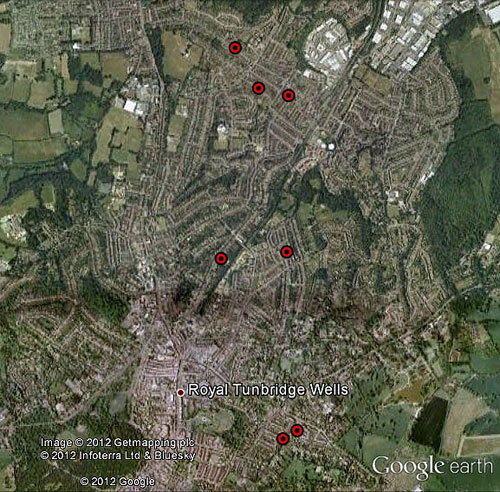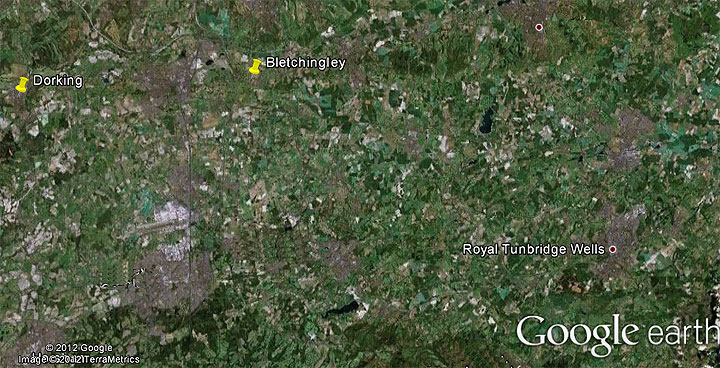Stop the Pigeon!
Posted: 23 November 2012 20:04
There has been a frenzy of media speculation about the content of a message with the remains of a wartime carrier pigeon discovered in a chimney in Surrey. I have nothing to say about the message itself, but do have an unsubstantiated theory about the bird's origin.
Not surprisingly, anything with a 'secret' wartime aspect generates many column inches and screen pixels, with theories ranging to involvement in D-Day, to connections with SOE and Bletchley Park.
I will only link to two pieces; firstly the BBC's story and the press release from GCHQ who have been unable to decipher the message.
I recently located some documents that describe the use of carrier pigeons for military purposes in Eastern Command in 1940. The birds were mostly owned by civilians who were members of the National Union of Racing Pigeons (NURP), although the army seems to have had its own mobile pigeon lofts too.
The system was simple; racing pigeons will (hopefully) fly back to the loft they regard as 'home'. If you take one with you on operations and need to send a message back, release the bird with the message and it flies back whence it came. The civilian owner then passes the message to the army. By employing birds from lofts in the vicinity of static army HQs, you have an efficient system of communications.
The Eastern Command Pigeon Service appears to have been set up in the latter half of June 1940, with the appointment of a Lt. Ching as Staff Officer. On 16 July, the first test of pigeon communications failed due to bad weather; a second test two days later was described as "fairly successful." The 21st, 22nd and 25th July all saw further tests, with timed tests on 4th and 10th August.

Lists and diagrams show at least 52 civilian and one mobile army loft in Eastern Command, from East Anglia to Middlesex, Kent, Surrey and Sussex.
Not all of these lofts have the number of pigeons recorded, but for those that do, a total of 1,513 birds can be calculated.
A war diary also gives us the names, and addresses of civilian fanciers supplying birds; of interest to us is the high concentration of lofts in Tunbridge Wells shown in the map at right.
(Tunbridge Wells is, of course in Kent and not East Sussex, and so not normally on my radar, but I do occasionally jump across the border.)
We have a total of seven civilian lofts made available to the army in August 1940; the birds from these lofts were to bring messages destined for 12 Corps HQ at Broadwater Down.
Now look at the map below; you can see Dorking and Tunbridge Wells marked. The remains of the pigeon were found in a house in Bletchingley in Surrey.

What is the significance of all these places? It's to do with the registration numbers of the two pigeons that carried copies of the same message; these were written on the message form recovered from the pigeon's remains. These appear to have been: NURP 40 TW 194 and NURP 37 DK 76.
According to the GCHQ website linked above, 'NURP' denotes the National Union of Racing Pigeons, the number that follows it is the year of registration, the two letters indicate the place of origin and the final number is the bird's individual indentifier.
My theory is this - and it may be completely wrong - does the TW denote Tunbridge Wells? By adding up the combined number of birds in lofts at Tunbridge Wells recorded as at the disposal of the army in August 1940, we get exactly 194, with one loft's complement not stated. If we have at least 194 birds in Tunbridge Wells, does this identify NURP 40 TW 194? Tunbridge Wells is just under 20 miles from where the bird was found. Does the 'DK' in the second bird number perhaps refer to Dorking, which is only nine miles away from Bletchingly???
Pure speculation; the message is undated and the 1940 documents do not list any lofts in Dorking, but there might have been some at a later date. It would make sense to send a copy to a different loft but in the same region; the 1940 chart, however, only describes a messenger service within Eastern Command.
The media is bandying a D-Day connection around, although this seems to be unsupported at this time. If there is any truth in this, was there an installation in this area that might be receiving messages from France in 1944? Broadwater Down does have a tunnelled headquarters, dug in 1941 as 12 Corps' Battle HQ, but I don't know if it was occupied during Overlord or not.
Anyway, these are just a few possibilities that spring to mind - they may subsequently be proven as completely groundless by the pigeon experts!
Were pigeons used much? I've seen very little documentation on them and only two mentions of troops encountering them; one, maddeningly, I can't find in my documents, but I did locate an instance of a carrier pigeon being spotted on the ground in Little Preston Street in Brighton on 11th September 1940 - unfortunately it took off before it could be captured!
No doubt the story of the Bletchingley pigeon will run and run. The strange thing is that the bird was reportedly found way back in 1982! If true, it took 40 years for the pigeon's message to be delivered, and only 30 years for the story of its discovery to break. This makes the media 25% more efficient than a dead pigeon...
- Pete

Email:
Blog Latest

Bishopstone reveals its pillbox secrets
18 October 2021

Pillbox or Observation Post?
10 June 2020

Uncovering the hidden secrets of a pillbox
8 June 2019

Review of 2018
31 December 2018

Wartime Christmas in East Sussex (2)
24 December 2018
Jargon-buster
War diary
A record of events kept by all units from the point of mobilisation. A diary's contents vary enormously from unit to unit; some give detailed entries by the hour on a daily basis while others merely summarise events on a weekly/monthly basis.
This site is copyright © Peter Hibbs 2006 - 2024. All rights reserved.
Hibbs, Peter Stop the Pigeon! (2024) Available at: http://www.pillbox.org.uk/blog/216713/ Accessed: 23 April 2024
The information on this website is intended solely to describe the ongoing research activity of The Defence of East Sussex Project; it is not comprehensive or properly presented. It is therefore NOT suitable as a basis for producing derivative works or surveys!